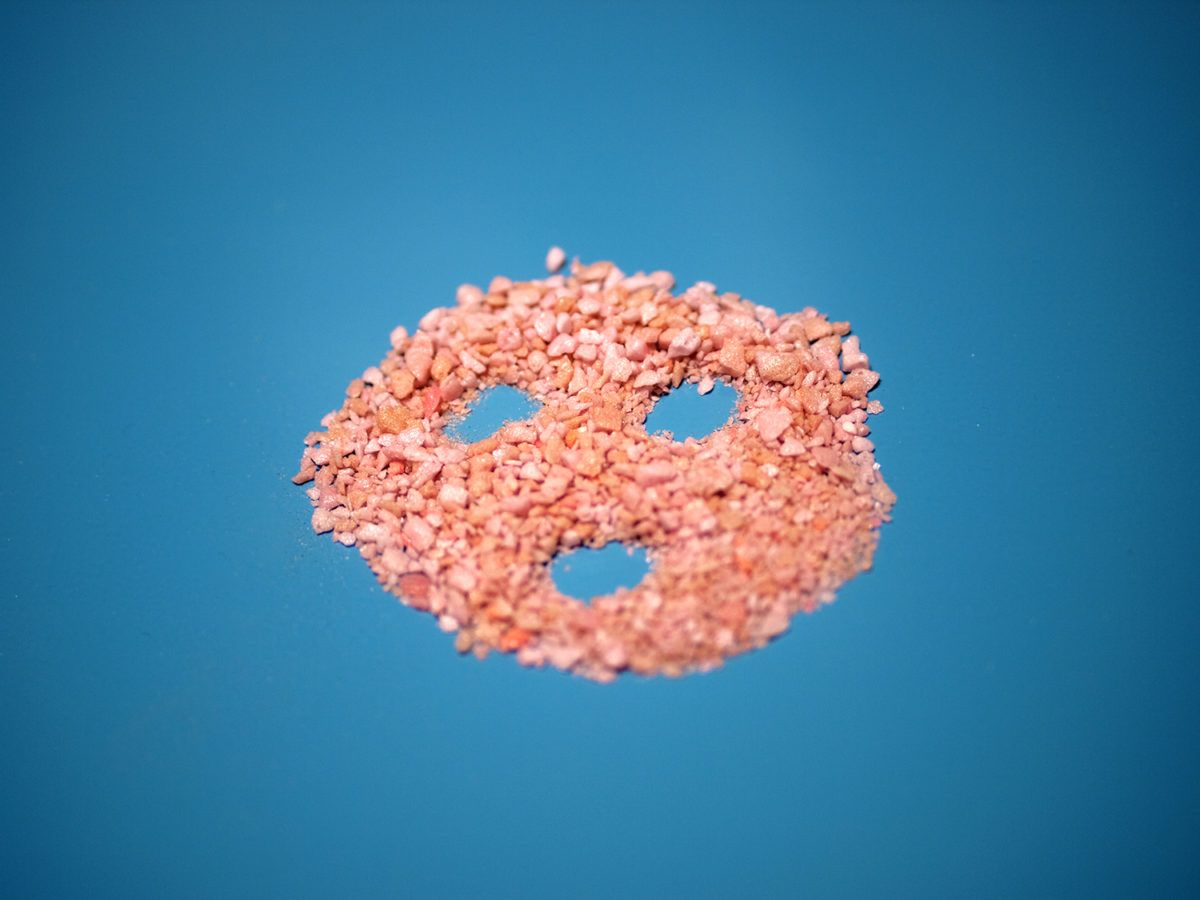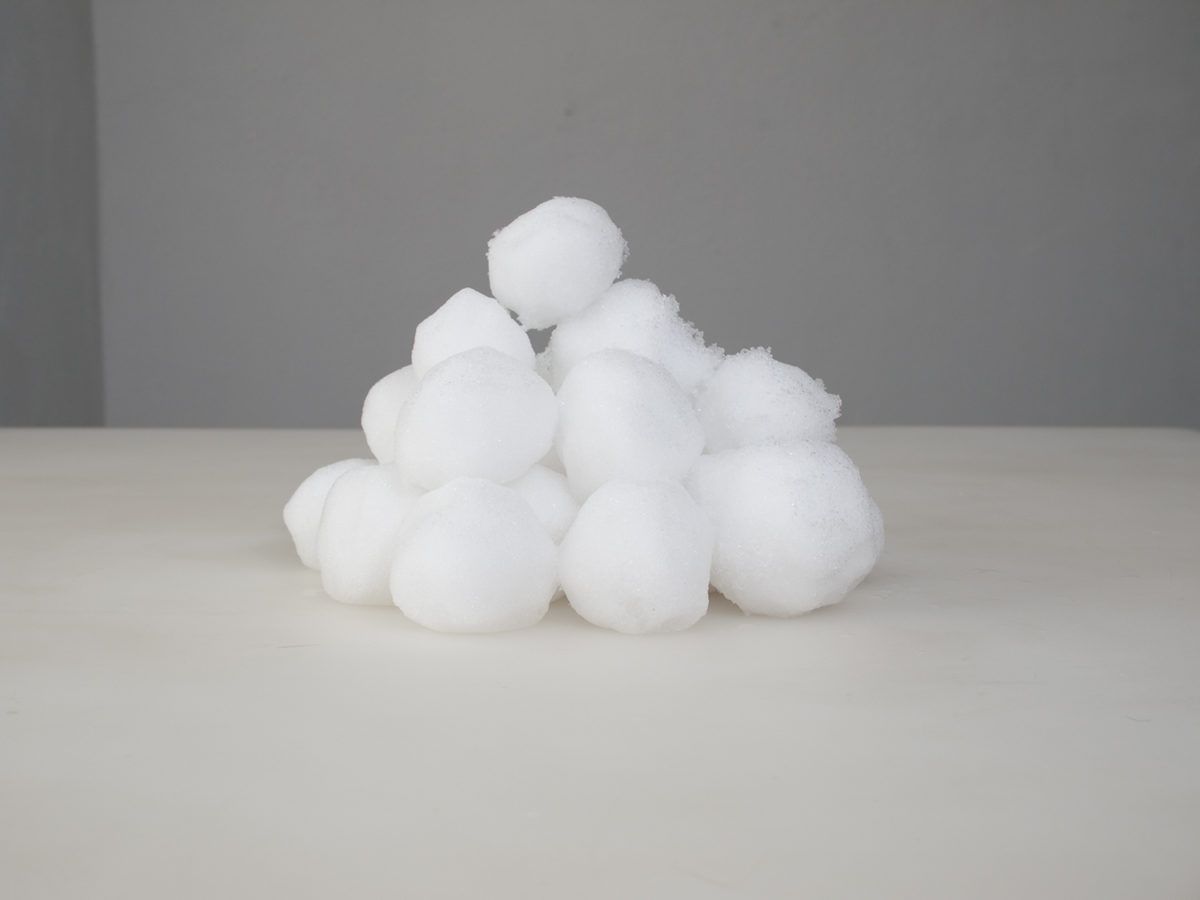blog
Book Review: Extinction Party by Jonathan Blaustein

Yellow mask and yellow plastic tablecloth © Jonathan Blaustein
Photographer, conceptual artist, and writer Jonathan Blaustein has been steadfastly working over ten years on a related series of projects that explore overconsumption absurdity, environmental disregard, all the while peppered with satirical comments on extinction-level problems. His photos, whether it’s of a row of tomatillos, or a clump of turf, are photographed against a plain background – the repeated mask motif is especially powerful. Each item is photographed in a style akin to slick Madison Avenue pops of color, form and line, or either artfully-lit, detailed museum catalog quality photographs. But while many of the objects are bright or jovial, the undertow in Extinction Party evokes the feeling that something underneath the surface is wrong. “Sure the ocean looks pretty,” Blaustein writes in his introduction, “but we’re eating all its fish, and replacing them with plastic toys and toxic chemicals. C’est la vie.”
Images from his acclaimed series The Value of a Dollar are included, where Jonathan chose to photograph food from around the world. The project was published by the New York Times in 2010, and subsequently went viral and seen by millions of people around the world. The project creates dialogue about the manner in which food represents deeper issues of wealth, class, power, health, and globalization – all at a time when the U.S. experienced the biggest economic collapse since the Great Depression (until now). The series crafts a visual language of equivalents equal in monetary value to each other. In a pair of images, one beautiful, plump, sun-like, yellow grapefruit is contrasted to four, dingy grapefruit from the bargain grocery. While each choice cost one dollar to purchase, one could wonder if the smaller, less appealing grapefruit tastes as good, or contains more toxic chemicals, therefore the choice between them speaks to issues of consumerism.
Extinction Party consists of images culled from four conceptually related projects – each featuring items presented for our careful consideration. In addition to the aforementioned The Value of a Dollar project, images from MINE presents objects gathered off his property in New Mexico, Recycling My Junk showcases years worth of semi-discarded trash in his former studio, and natural-resource-depleting party supplies from Party City is the Devil. Anyone for beautiful tongue-in-cheek conceptual photos about over consumption absurdity leading to inevitable extinction level events? Yes, please.
At the time Extinction Party released in March of 2020, the world grappled socially and politically with the impact of climate change; and then added a global pandemic and a gigantic economic free fall to boot. When we talked about the book in a larger sense, Jonathan reflected on making art at a certain time in one’s life, asking the big questions about our legacy for our children and the planet, and the natural progression one makes in a life in the arts. In thinking about his first book in his career, he remarked that the timing was right and it was only natural that his creativity would evolve from image making into other avenues as well, and that his interconnected projects would culminate in book format.
The idea of Value and its implied meanings, carries across all the included work. We had a conversation about the question of how value is decided, who decides and why? “What we care about has a lot to do with the place where we were raised, and the time in which we’re raised,” Jonathan said. The consistent message is that the value we choose to assign to items “is really more engrained than chosen. People make decisions based on their cultural influences, who their parents are, or the place they grow up… but it’s also about what we care about and what we’re willing to spend.” Jonathan expanded on this idea by saying, “A big part of the way I looked at this larger project was through economics. A tenet of capitalism says the way to create growth is to maximize the value of your existing resources.” As in his project, MINE, items on Jonathan’s property that he owns, can be exploited and then sold to create wealth. “And with The Value of a Dollar, you could buy the ‘thing’ for a dollar – or you could buy a picture of the ‘thing’ for one-thousand dollars. It’s a game in a sense… I’m using the structural metaphors of capitalism to comment on it,” Jonathan explains.
Collectively these projects create a larger visual language of equivalents for us to examine, explore and question. Jonathan explores these concepts and translates them into a vocabulary of forms with a universal syntax. During our conversaton, he made a strong analogy to Chinese landscape paintings, and I would add Zen calligraphy. Jonathan’s practice is greatly influenced by his art history courses concentrating on Chinese landscape paintings. “There is a lot of influence from my art history background… I looked at food as a language – as a symbol set, and the way I wanted to treat it was really inspired by these 800 year old silk scrolls that really communicated that hyper-seeing, Zen way of looking. That’s where the object in the middle of the white negative space came from… I was using it as an intentional concept. Like a Zen Buddhist monk creating the perfect little persimmon…”
The collective concept is encompassed by the idea of the “perfect isolated mark on the paper.” While a smooshed cheeseburger is far from being an idealized form, the iconography of burgers, candy necklaces, snowballs, dead mice, tin foil, or a deer paw all breathe with the vitality of eternal experience. With Zen calligraphy, the art implies that the artist’s brush is moving long before it ever hits the paper. The mark left on the paper is a trace of the motion only where, and why, it needs to be seen. In this sense, the measure of quality in a piece of Zen calligraphy, the perfect little persimmon, or a Halloween mask is not what it shows you about the artist – but what it shows you about yourself.

Blue streamers and red plastic tablecloth © Jonathan Blaustein

One dollar’s worth of double-cheeseburger from McDonalds © Jonathan Blaustein

My deer head © Jonathan Blaustein

My icicles © Jonathan Blaustein

Don’t worry everything is going to be OK? © Jonathan Blaustein

My snowballs © Jonathan Blaustein

One dollar’s worth of tomatillos from Mexico © Jonathan Blaustein

No one’s hands are clean © Jonathan Blaustein

Yellow plastic fedora and yellow plastic tablecloth © Jonathan Blaustein

Extinction Party
by Jonathan Blaustein
Essay by Kevin Kwan
Designer: Caleb Cain Marcus
Hardcover, four variations 10 x 7.5 inches
96 pages, Edition of 400
Published by Yoffy Press. Released in March, 2020
Jonathan Blaustein is an artist, writer, and educator based in Taos, New Mexico. He has exhibited his work widely in galleries and museums the US, and in festivals in Europe as well.
His photographs reside in several important collections, including the Library of Congress, the State of New Mexico, the Brooklyn Museum, and the Museum of Fine Arts, Houston.
Jonathan is a weekly columnist at the popular blog A Photo Editor, and spent six years as a photo critic at the New York Times Lens blog as well, with previous bylines online for The New Yorker, VICE, and Hyperallergic. He taught photography at UNM-Taos for many years, and recently founded the Antidote Photo Retreat at his family horse farm outside Taos.
Location: Online Type: Book Review
Events by Location
Post Categories
Tags
- Abstract
- Alternative process
- Architecture
- Artist Talk
- artistic residency
- Biennial
- Black and White
- Book Fair
- Car culture
- Charity
- Childhood
- Children
- Cities
- Collaboration
- Community
- Cyanotype
- Documentary
- Environment
- Event
- Exhibition
- Faith
- Family
- Fashion
- Festival
- Film Review
- Food
- Friendship
- FStop20th
- Gender
- Gun Culture
- Habitat
- Hom
- home
- journal
- Landscapes
- Lecture
- Love
- Masculinity
- Mental Health
- Migration
- Museums
- Music
- Nature
- Night
- nuclear
- p
- photographic residency
- Photomontage
- Plants
- Podcast
- Portraits
- Prairies
- Religion
- River
- Still Life
- Street Photography
- Tourism
- UFO
- Water
- Zine

Leave a Reply